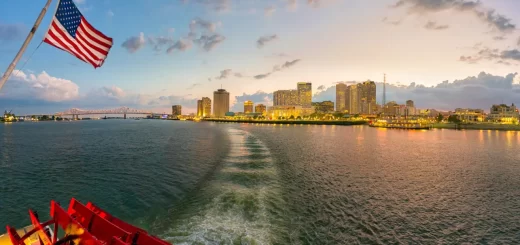Cruising the Lower Mississippi River on American Queen reveals a sleepy South

Calm Mississippi River waters reflect the sunset, which brings out the ornate Victorian details of the American Queen, the last steamboat carrying overnight passengers on the river. (Cathryn Knezevich)
My recent weeklong Mississippi River cruise on the American Queen took me back through history on the last overnight steam paddlewheeler plying the muddy waters between New Orleans and Memphis. Traveling the 640-mile-long Lower Mississippi let me discover Cajun and Creole cultures, visit alligator-populated bayous and tap my toes to jazz, blues and cartoon-like music from a steam calliope.
Built in 1995 and carrying more than 400 passengers, the American Queen is a replica of the long-gone original paddlewheelers, but its details are very authentic-looking. Paintings of those older boats in ports such as Louisville, Pittsburgh, Mackinac Island and Cleveland are in public spaces throughout the ship.

The American Queen’s sun deck has a small pool, heated for relaxing in any weather. (Cathryn Knezevich)
My sold-out voyage was framed around food, celebrating the collaboration between “America’s Test Kitchen” with Regina Charboneau, American Queen Voyages culinary ambassador, to bring flavors of the six rivers sailed by the cruise line to dining venues.
“We delved into the culinary history of North America’s riverside communities to bring travelers a taste of the past and present, with recipes celebrating the diverse flavors of the various regions,” said Bridget Lancaster, co-host of “America’s Test Kitchen” and its editorial director.
The two women led daily cooking demonstrations in the ship’s palatial two-story Grand Saloon.
The collaborative dishes introduced on the ship’s menu included those from towns along the Upper and Lower Mississippi; the Pacific Northwest; the Ohio, Cumberland and Tennessee rivers; and Alaska’s Inside Passage. Get recipes, learn more about the American Test Kitchen and American Queen Voyages and discover the women’s kitchen techniques in an upcoming story.

The American Queen’s elegant JM White Dining Room awaits passengers with its Victorian stained glass, ornate drapery and gold gilded ceiling details. (Janet Podolak)
A drought in many of the 31 states that provide water to keep the Mississippi River flowing meant delays for our cruise as the river silted up and needed dredging by the U.S. Army Corps of Engineers. The many barges carrying freight backed up behind us as tinny notes from the steam calliope’s keyboard entertained those of us at the River Grill, perched on Deck 5 above the bright red paddlewheel carrying across the water to the barges. A reward of the delay was two nights spent in Natchez, where its sister ship the American Countess also was docked. Although it appears as a smaller version of the Queen from the outside, its interior is more like a modern hotel.
Natchez is home for Charboneau when she’s not aboard American Queen ships.

A server replenishes lobster tails and shrimp for the American Queen’s lavish Sunday brunch buffet. (Janet Podolak)
There’s not much to see along this part of the river because riverbank views are blocked by tall concrete levees built to prevent flooding and keep the river within its banks. This is rural cotton and sugar cane country, so settlements, which are further ashore, are few and far between. When the ship stopped so passengers could go ashore in St. Francisville and Natchez, it was secured to the levee and shore-side trees. Golf carts met passengers at the gangway to deliver them to buses for shore excursions.
An excursion with Cajun Pride Swamp Tours was my choice when we left the bus at the included Nottaway Mansion tour for an hour’s drive through sugar cane fields and through a meandering bayou absorbing overflows when rivers flood and change their course.
Upon arrival at the privately owned swamp, we boarded a flat-bottomed boat so our Cajun captain could share the lore of his people, who migrated to French-speaking Louisiana when they were expelled from Nova Scotia by the British in 1755. At first, his Cajun accent was difficult to understand, but our ears soon became accustomed to its musical French cadence, and we learned how “Acadian” in Canada became “Cajun” in Louisiana.
On cold days like this one, alligators customarily bury themselves in the mud, so our expectations to see them were low. But the reptiles are accustomed to being fed from the tour boats, and our captain lured them out with marshmallows. Raccoons competing for marshmallows from shore crept from the woods to steal them from the gators until the large reptiles crawled ashore to get their fill. We held our collective breaths fearing for the plump and furry raccoons.
“Alligators are territorial,” our guide told us, adding that hunting them is strictly regulated by the U.S. Fish and Wildlife Service. He said many of those in the Cajun community live off the bounty of the bayous, valuing alligators as a valuable source of income for their meat and to make leather belts. But hunting license tags are issued by the Fish and Wildlife Service according to the number of alligators and the size of the area where they live. Fines are steep for those who violate the rules.

Seen from a flatboat on a swamp tour, an alligator stalks a trio of raccoons intent on stealing snacks tossed ashore. (Janet Podolak)
Later, on the bus trip back to the ship, another guide pointed out what appeared to be houseboats anchored beneath the highway, seeming suspended over the black bayou water. Basic and simple, they’re the year-round homes of the superstitious Cajuns and sport mirrors on their front doors to keep the devil away. Many believe in ghosts and apply their superstitions to their lives — such as believing the ends of a bread loaf should not be eaten or they’d never make ends meet.
It was Halloween, so ghost stories and other scary legends were shared.
That night, back aboard the ship, the Monster’s Ball, a gala Halloween party, drew costumed guests for a night of live-music revelry. Although the average age of passengers was likely in the 70s, many dancers recalled their rock ’n’ roll roots with lively moves and nimble footwork.

Nimble seniors dance and dip to live music at the American Queen’s Monster’s Ball, where many came in costume for Halloween. (Janet Podolak)
The American Queen, like other cruise line riverboats, structures shore time so passengers can join in seasonal celebrations ashore.
Lovely Natchez, although being shelled by a Union ironclad from the river, largely escaped damage during the Civil War. Historic structures are well-maintained, and the 14,000-person town goes all-out for Christmas with competitions among its garden clubs. Christmas markets are a seasonal treat where American Queen passengers buy sweet and savory foods to take back to the ship and quality handcrafts to bring home as gifts.

Rivalries among Natchez, Mississippi, garden clubs contribute to the holiday season beauty of the town, where steamboat passengers come ashore to enjoy Christmas markets. (Courtesy of Visit Natchez)




Recent Comments